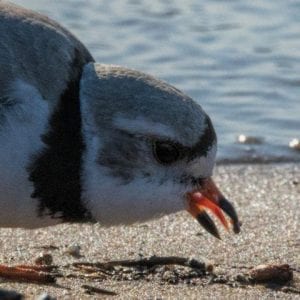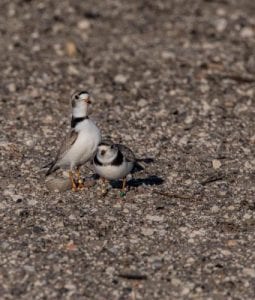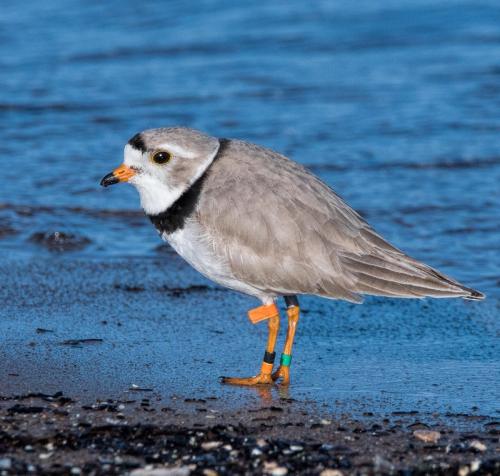Early May

(c) Jim Beecroft
There are currently four pair of piping plover at Wasaga Beach Provincial Park! To minimize impacts, or limit disturbance, to the birds, perimter fencing has been put in place around the area that the birds are using for feeding, nesting and mating. As a change this year, rope fencing is being used as opposed to snow fencing. The rope fencing, strung between T-bars, is refered to as ‘psychological fencing’. The psychological fencing will provide as less unsightly barrier for protection.

© Neal Mutiger
Piping plover feed along the shoreline, eating insects and spiders.
Volunteer Guardian Information

(c) Enrique Photo
Now that the plovers are here, we are recruiting both returning and new piping plover guardians. Volunteer training for the 2018 season is at: Nancy Island Histric Site theatre on Friday, May 25 at 5:30pm.
New to this year, returning volunteers are not required to attend the spring time training session. The training session will be specifically aimed at new volunteers or those with basic knowledge that would like a refresher course.
For more information, please contact Patricia at (705)429-2516 or Patricia.L.Davidson@ontario.ca
May 11

© Neal Mutiger
Ploverland has been busy over the past week. Our first pair has nested and to protect the site from predators, a mini exclosure has been placed over the scrape. A full sized exclosure will replace the mini exclosure in the near future. In the meantime, the mini exclosure will work well to keep predators (gulls, etc.) away from the four eggs. Two other pairs of plovers are busy establishing their territory. A fourth pair has not been seen recently, but their absence is unlikely due to predation. Pairs will seek nest sites in other areas and so this is considered to be highly likely in this case. We are continuing to survey other potential nesting sites.
May 24
Exciting news! We now have placed full sized predator exclosures over each of the three plover nests! We were delayed in placing the larger sized exclosures due to the cooler weather that we have been having. While placing the larger exclosures we try to minimze the disturbance to the birds so as to limit the amount of time that they are away from incubating the four eggs in each of the nest scrapes. Warmer weather is prefered so as to not have the chance of the cooler weather impacting the eggs while the adults are off of the nest.
The boardwalk in Beach Area 1 has been slightly rerouted and fenced to provide the birds on Nest #3 space to incubate comfortably. Fencing will be removed after the eggs hatch.
In addition to Wasaga Beach’s three nests, there are two in Sauble Beach. As of May 20th, across the Great Lakes region, there are thirty active nests! A few single piping plover have been identified at other sites within Ontario.
June 9
One June 6 four chicks successfully hatched from Nest #1 in Wasaga Beach! Unfortunately less than 24 hours after the hatching, three of the four chicks were lost. The most likely cause is predation from an unknown source, though the likely suspects are gulls, crows or merlins.
As visitors to Wasaga Beach, we can help to minimize the presence of some of these predators by ensuring that our garbage, which attracts both gulls and crows, gets into proper garbage receptacles. It is also important to note the dangers of feeding gulls. While it can be fun for children, it attracts gulls and those very gulls can eat plover chicks. Also, it creates a feeding frenzy and chicks can get caught in them, sometimes resulting in the chicks being eaten.
While visiting Ploverland, be sure to touch base with one of our helpful volunteers. They are eager to share information with you about the plovers, their habitat, and how they are protected. You can see model eggs and learn how colour bands, which identify each bird, are read. There are spotting scopes and binoculars on site which may help you to view the adult plovers and any chicks.
Great Lakes Plover Population Update
The Great Lakes Piping Plover population, which includes the areas of Minnesota, Wisconsin, Illinois, Indiana, Michigan, Ontario, Ohio, Pennsylvania and New York, has 53 pairs as of May 31.
Ontario Population (8 nests total)
Wasaga Beach 3 nests, Sauble Beach 3 nests, Darlington 1 nest, Toronto Islands 1 nest
We are looking forward to the hatching of the chicks from both Nest #2 and #3!
June 13

(c) Neal Mutiger
Great news! Yesterday the four chicks from Nest #2 hatched. By 7:30am today the family had made their way to the shoreline. As of tomorrow, the west end of the boardwalk will be reopened to the public. The chick from Nest #1 is now banded.
June 15

(c) Neal Mutiger
By the end of the day, the four chicks from Nest #3 had hatched! That brings our total number of chicks currently at Wasaga Beach to 9! Be sure to come by Beach Area 1 on June 16 and June 17, between 10am and 4pm, for Ploverpalooza. At the event you can join in various fun actives and learn about piping plovers. Hopefully you will also get a chance to see one or more of the chicks!

(c) Neal Mutiger
June 18
Great Lakes Population Update
Wasaga Beach – 9 chicks
Sauble Beach – 1 nest of three has hatched (June 16th)
Darlington – 1 nest with chicks to hatch any day
Toronto Islands – 1 nest with chicks to hatch any day
63 Total pairs for the Great Lakes Population (64 nests total -1 of which must be a re-nest); there are currently 17 broods (i.e., family groups of chicks); and 15 eggs at the captive rear centre.
June 26
We are always excited for the chicks to reach about two weeks of age as that is when banding occurs. This happened yesterday for the chicks of Nests 2 and 3. On banding days, trained Park staff, along with folks from Canadian Wildlife Service, arrive shortly after sunrise to locate the chicks. Once located, the staff herd the chicks into a circle, where special net-like contraptions are used to gently collect each chick. Each chick is then carefully transferred to a soft holding bag and then taken to a central banding location on the beach. Once each chick is weighed and banded, they are released, line of sight, to their parents. The staff record each chick’s individual identification bands and the information shared with the Great Lakes Piping Plover recovery teams.
Banding –
Each entire brood (i.e., 4 chicks) are given the same colour band combination, but each bird also has a unique, hard to read number on their bottom band. Sometimes coloured dots are also used on the bands. For example, a yellow band may have a green dot.

(c) Neal Mutiger

(c) Neal Mutiger

(c) Neal Mutiger

(c) Neal Mutiger

(c) Neal Mutiger
A note on the weight of chicks –
At banding, four chicks at the age of 11 days, weighed 14g, 19.5g, 15g and 15g. Chicks from the earlier nest, which were at the age of 14 days, weighed 21.5g, 22g, 22.5g, and 18.5g!
July 7

(c) Neal Mutiger
Our chicks are working towards fledging. ‘Fledged’ means that the chicks muscles and feathers are sufficiently developed for flight. A chick is considered ‘fledged’ when it can fly at least 50 meters. A young fledgling is able to fly but is still dependent on parental care for a little while longer. Average length of time: 20-25 days to make short flights and 25-30 days to maintain flight.
A note on Wasaga Beach’s plover area –
Our closed off plover area, delineated by a perimeter fence, only covers 2% of Wasaga Beach’s 14 kilometre long beach!
July 13

(c) Neal Mutiger
This week our fledged numbers are 5 out of 9, with more expected to fledge over the next week! We did have an unexpected surprise this week in that one of the adult plovers was observed with a piece of thread, holding a small twig, around its ankle. It was decided that while not currently impeding the adult, the twig did need to be removed to prevent any injury or further entanglement. On July 11, John Brett from Environment Canada, arrived with a mist net (similar to a volleyball net, but extends from the ground up about 10 feet and is incredibly light due to the fine netting) to ‘catch’ the adult and remove the string and twig. To catch an adult, which is very difficult to do, you attempt to ‘walk’ the bird towards and into the net. Unfortunately the bird kept flying up and away from the net. The adult was finally caught after laying the net flat and having the bird walk onto it. The string and twig were successfully removed and the healthy birds was released. The entire process took about 2.5 hours!

Juvenile plover
(c) Neal Mutiger
July 27
Wednesday, July 25 brought an end to Wasaga Beach’s 2018 Piping Plover season. All chicks are fledged, fully independent, and ready for their journey south to their wintering grounds.
A final season update will be provided as all the data comes in from this year’s piping plover programs. Until then, it appears as though there were 67 Great Lakes Piping Plover pairs, 68 nests and 115 fledged wild chicks (as of July 21). A few more chicks are expected to fledge and one nest is still in incubation (July 21).
Thank you to all of our volunteer Piping Plover Guardians for their help this summer!
We look forward to the 2019 Piping Plover season.
Autumn
Worsley, also known as Little Cooper, was identified earlier this season on Hilton Island, South Carolina. It is easy to identify the Great Lakes Piping Plovers by their orange band, located high on their leg. Worsley hatched in a captive rearing centre in Michigan in 2012. This past summer at Wasaga Beach he successfully reared four chicks, two of which have been positively identified on wintering grounds. Ontario Great Lakes Piping Plovers have also been identified this year on Florida wintering grounds.

